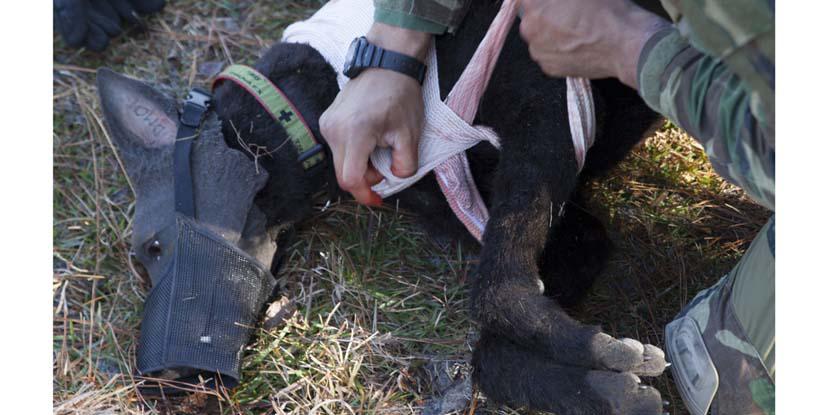SOCOM Leashes Up a New 'Robot Dog'
U.S. Marine Corps soldiers in the Special Operations Command (SOCOM) are adding a new tool to the doghouse: a “robot dog” for hands-on canine medical training. The realistic dog mannequin simulator, used recently for the first time at Camp Lejeune in North Carolina, will help the soldiers improve their canine medical skills, according to a report by Cpl. Bryann Whitley, USMC.
Several canine handlers at Camp Lejeune’s Stone Bay used the prototype to practice applying medical dressings during multipurpose canine (MPC) medical training held November 30 and December 1. The simulation presented the handlers and medical staff with a wide range of challenging scenarios, including realistic reactions to injuries and treatments, Whitely reported. “All of the joints on the mannequin move like a real dog’s, unlike a jerry dog where there is no movement,” the report stated. “Limbs can also be changed out, to simulate different injuries depending on the training scenario’s objectives.”
The robot dog looks like a Belgian Malinois, a breed commonly used in military canine forces.
The simulator is one of two prototypes that SOCOM and industry partners are developing to improve the level of handlers’ medical training. According to the report, the special operations forces community currently uses stuffed dogs, referred to as critical-care jerry dogs, to train and refine medical techniques. However, the static nature of the stuffed dogs limits the instructors’ ability to evaluate dog handlers’ and medical team members’ capabilities in properly performing medical aid on canines. Handlers also have to rely heavily on force veterinarians to provide scenarios and injury descriptions, which limits training to garrisons since veterinarians aren’t deployed with soldiers and their canines. Once deployed, canine handlers must rely on their own abilities to determine any injuries to their canine.
“Our handlers are the first line of aid for their dogs when deployed, secondary to special amphibious reconnaissance corpsmen,” said a U.S. Marine Corps Special Operations Command (MARSOC) East force veterinarian in the report. “They are the first responders, so they need to know how to treat any injury that happens on the battlefield.”
The robot dog simulator will help the handlers improve how they administer aid to their canines to stabilize any injuries before the animal can been seen by a veterinarian. “[Having this capability during training] helps you not second guess yourself when deployed,” said a MARSOC canine handler in the report. “You’re able to realize that you’ve used these steps before in training. And they worked in training so they will work when needed. As long as you continue with the steps and do everything properly, you’ll be successful and save your dog."




Comments